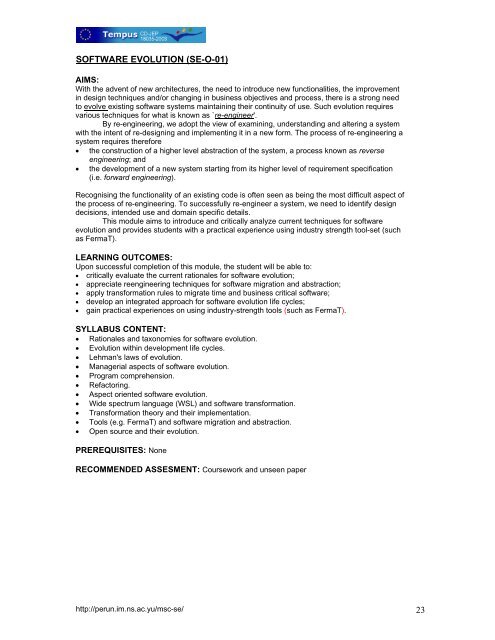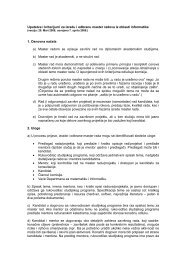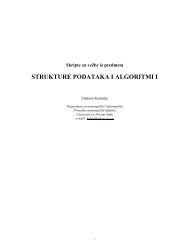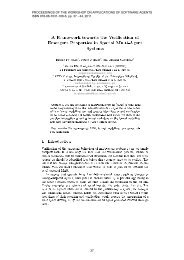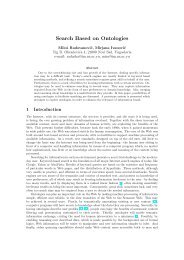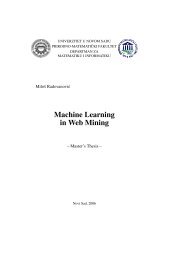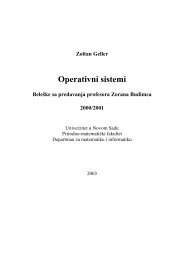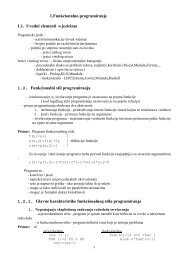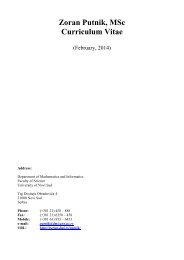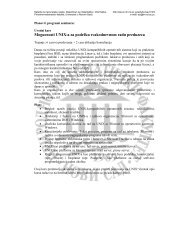Full document describing all aspects of the curriculum, release 2 (pdf)
Full document describing all aspects of the curriculum, release 2 (pdf)
Full document describing all aspects of the curriculum, release 2 (pdf)
Create successful ePaper yourself
Turn your PDF publications into a flip-book with our unique Google optimized e-Paper software.
SOFTWARE EVOLUTION (SE-O-01)AIMS:With <strong>the</strong> advent <strong>of</strong> new architectures, <strong>the</strong> need to introduce new functionalities, <strong>the</strong> improvementin design techniques and/or changing in business objectives and process, <strong>the</strong>re is a strong needto evolve existing s<strong>of</strong>tware systems maintaining <strong>the</strong>ir continuity <strong>of</strong> use. Such evolution requiresvarious techniques for what is known as `re-engineer'.By re-engineering, we adopt <strong>the</strong> view <strong>of</strong> examining, understanding and altering a systemwith <strong>the</strong> intent <strong>of</strong> re-designing and implementing it in a new form. The process <strong>of</strong> re-engineering asystem requires <strong>the</strong>refore• <strong>the</strong> construction <strong>of</strong> a higher level abstraction <strong>of</strong> <strong>the</strong> system, a process known as reverseengineering; and• <strong>the</strong> development <strong>of</strong> a new system starting from its higher level <strong>of</strong> requirement specification(i.e. forward engineering).Recognising <strong>the</strong> functionality <strong>of</strong> an existing code is <strong>of</strong>ten seen as being <strong>the</strong> most difficult aspect <strong>of</strong><strong>the</strong> process <strong>of</strong> re-engineering. To successfully re-engineer a system, we need to identify designdecisions, intended use and domain specific details.This module aims to introduce and critic<strong>all</strong>y analyze current techniques for s<strong>of</strong>twareevolution and provides students with a practical experience using industry strength tool-set (suchas FermaT).LEARNING OUTCOMES:Upon successful completion <strong>of</strong> this module, <strong>the</strong> student will be able to:• critic<strong>all</strong>y evaluate <strong>the</strong> current rationales for s<strong>of</strong>tware evolution;• appreciate reengineering techniques for s<strong>of</strong>tware migration and abstraction;• apply transformation rules to migrate time and business critical s<strong>of</strong>tware;• develop an integrated approach for s<strong>of</strong>tware evolution life cycles;• gain practical experiences on using industry-strength tools (such as FermaT).SYLLABUS CONTENT:• Rationales and taxonomies for s<strong>of</strong>tware evolution.• Evolution within development life cycles.• Lehman's laws <strong>of</strong> evolution.• Managerial <strong>aspects</strong> <strong>of</strong> s<strong>of</strong>tware evolution.• Program comprehension.• Refactoring.• Aspect oriented s<strong>of</strong>tware evolution.• Wide spectrum language (WSL) and s<strong>of</strong>tware transformation.• Transformation <strong>the</strong>ory and <strong>the</strong>ir implementation.• Tools (e.g. FermaT) and s<strong>of</strong>tware migration and abstraction.• Open source and <strong>the</strong>ir evolution.PREREQUISITES: NoneRECOMMENDED ASSESMENT: Coursework and unseen paperhttp://perun.im.ns.ac.yu/msc-se/ 23


